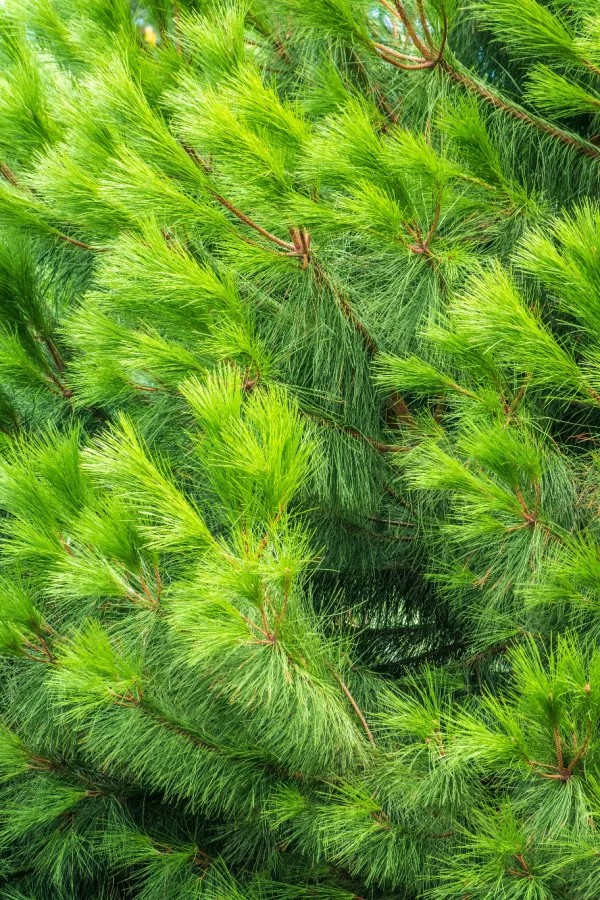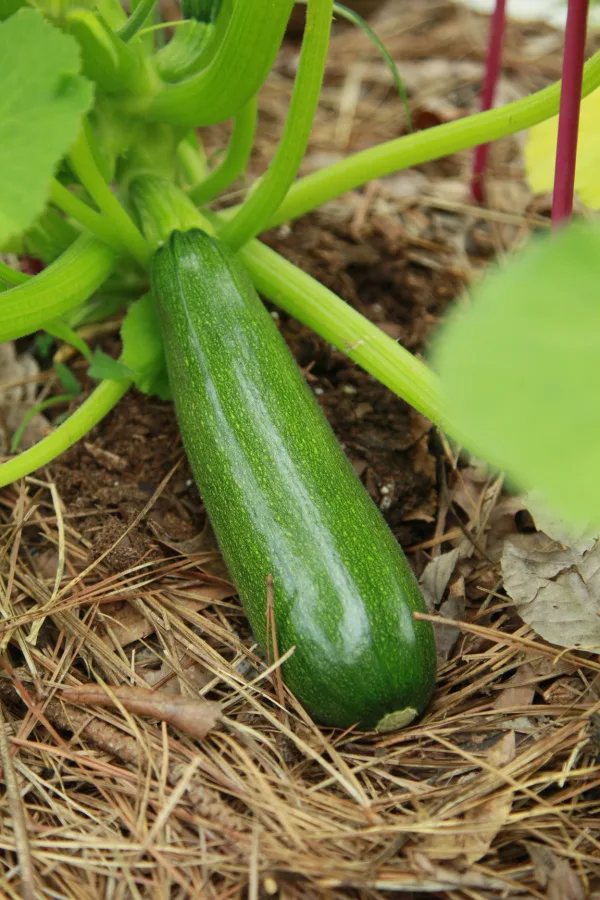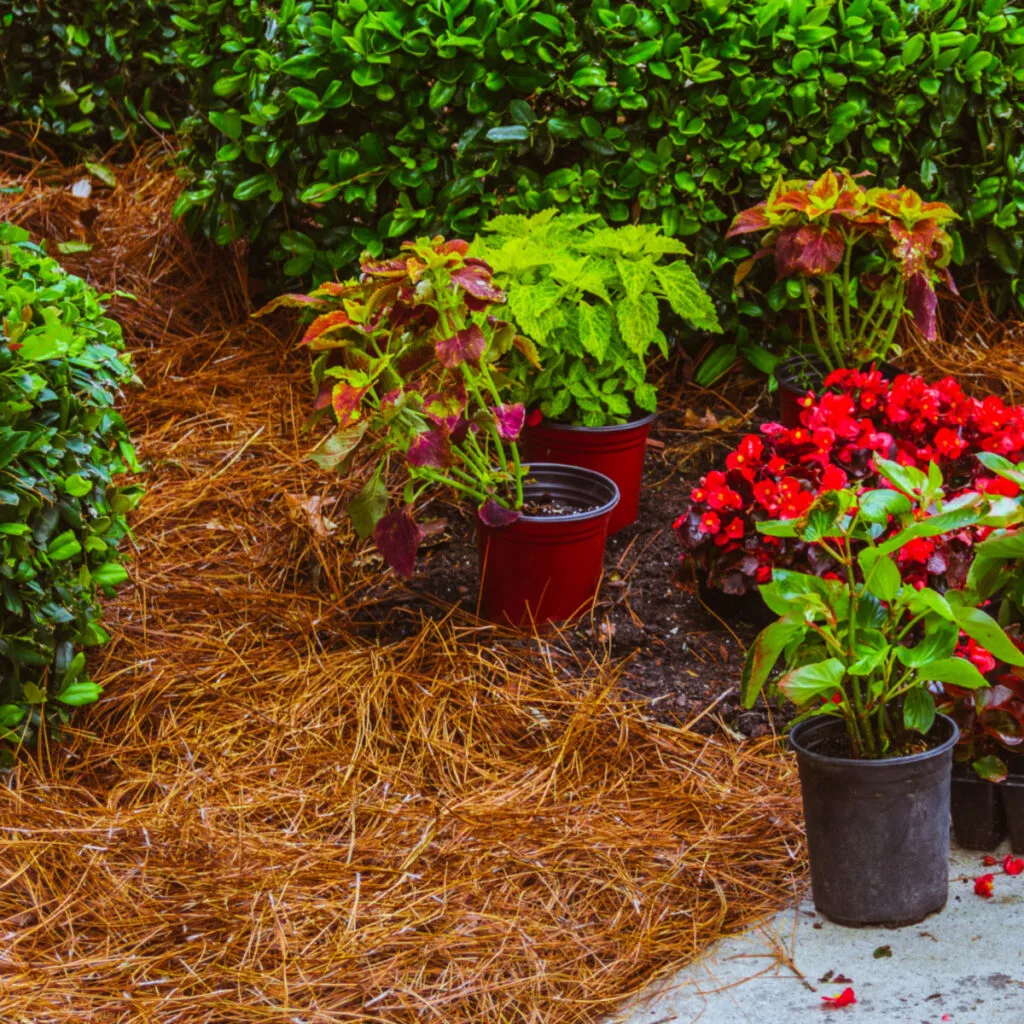Looking for a way to use all of those falling pine needles as a mulch in your flowerbeds, gardens and landscape?
If you happen to live in an area with pine trees, you know how abundant their needles can be. Especially in the fall! Even though pine trees are evergreens, that doesn’t mean they don’t shed some of their needles. In fact, most pine trees drop a portion from their branches every single year.
A large majority of pine tree species shed their needles in late summer and fall. There are, however, a few species that drop some of their canopy in the spring. But one thing is for sure, whenever they do, they can leave quite a thick layer of needles piled up on the ground! And the question becomes – just what can you do with all of those falling needles?

Do Pine Needles Change The Soil Where They Lay?
There is a lot of confusion when it comes to using pine needles. Even more so when it comes to using them in flowerbeds, raised beds and in vegetable gardens. Most of that confusion centers around their acidity, or more to the point, will they harm or help the plants you use them around.
As you will see below, pine needles – at least dried pine needles that have fallen to the ground – are not acidic. And because of that they can actually make an incredible mulch almost everywhere, including in the vegetable garden.
But the key to success is knowing just where to use them and how to put them down – and where it’s best not to use them as well. With that in mind, here is a look at how to put all of those falling pine needles to work in your landscape.
How To Use Pine Needles As A Mulch
Believe it or not, pine needles really can work amazingly well as a mulch. And with all of the free needles that fall each and every year, an incredibly inexpensive mulch at that!

Before we get into where and how to use them as a mulch, let’s first cover the topic of the acidity of pine needles – because it certainly causes a lot of confusion among gardeners when it comes to utilizing them in their landscape.
Pine Needles & Acidity – How To Use Pine Needles As A Mulch
Many gardeners mistakenly think that dead pine needles are acidic. Even more, they also believe that using them as a mulch or on top of soil will turn the soil more acidic. The truth is, dead pine needles are not acidic in the least. And they won’t change a soil’s pH either.
The only pine needles that are acidic are green (live) needles. This is why if you are trying to help acid loving plants such as blueberries, rhododendrons or azaleas, you need to mulch them with green needles – not dead pine needles.
As green needles start to die off, they do release and help add acid to the surrounding soil. But once they are dead – they are nothing more than a neutral mulch. Because of this, there is absolutely zero harm in using them in flowerbeds and vegetable gardens.

What does make a big difference for where and when to use pine needles as a mulch is the physical makeup of the needles themselves. The waxy, slow to break down coating of needles can be an advantage in some mulching situations. Meanwhile, in other situations, it can actually leave plants without protection.
With that in mind – here is a look at some of the best places to use pine needles for mulch – and some to avoid.
How & Where To Use Pine Needles In Vegetable Gardens
In the vegetable garden, pine needles are great for using in walking areas and to help keep fruits and vegetables that grow on the ground safe. They are not, however, good for mulching directly around plants.
Placing a thick 6 to 8 inch coating of needles down in between each of your planting rows can keep competing weeds at bay. It also will make it far easier to work the garden -as having a mulch between rows keep them from becoming muddy from rain and dew. It also keeps you from having to ever till this non-growing space.
Pine needles are also great for protecting fruits and vegetables that form on or near the ground. Zucchini, cucumbers, squash and pumpkins can all benefit greatly from pine needles under their fruit.

The needles keep the moist earth from touching the fruit as they form. This can not only keep it blemish free – but keep it from rotting out. Even better, it keeps them more safe from ground dwelling insects. Finally, because water can pass easily between the waxy needles, it also helps to keep them sitting in moist soil.
Using Pine Needles Around Vegetable Plants
So why not use pine needles right up around vegetable plants as a mulch? Although it will keep weeds out a bit, pine needles do not provide good insulation for plants. Nor do they help keep moisture in the soil as well as hardwood mulch, shredded leaves, straw and other organic choices.
Again, you can use them around plants without harming them. It doesn’t change the soil’s pH. Nor will it choke the plants or keep nutrients from getting to them. It’s just that the other organic mulch choices above perform better – and add more nutrients to the plants as they break down.
Where To Use Pine Needles In Flower Gardens
In flowerbeds, pine needles can be used at will! A thick six inch coating in between perennials can help to keep competing weeds down. Even better, it can also serve as a barrier for blowing seeds to find the soil below.
Best of all, pine needles allow water to pass through easily. There is little worry of rain and/or watering to not reach the plants roots. And if you happen to have free access to needles, it can save a bundle of mulch purchases year after year!
Even more, once established, most perennial flowers and even annual flowers do not need as much attention as vegetable plants. And for those that do, you can still put a few inches of hardwood mulch or shredded leaves underneath – and then top off with pine needles for a great look!
Using Pine Needles To Help Acid Loving Plants In Flowerbeds – How To Use Pine Needles As A Mulch
So what about those acid loving plants and pine needles we talked about earlier in the article? When trying to help give acid loving plants the nutrients they need, it’s all about using green needles.
Simply cut some fresh pine and needles from an existing pine tree. Next, pull back any existing mulch that might be around your acid loving plants. Then, work in several inches of your green needles into the top of the soil surface. Finish by covering over the green needles with the existing mulch you pulled back.
As the green needles die off, they will help to acidify the soil. And by burying them in the top level of soil under any existing mulch – it will leach in more quickly.
Last but not least, we are often asked about composting pine needles. Like all organic matter, pine needles will eventually break down into compost. However, that waxy coating simply takes too long, and for home compost piles – and they are best left out. For more tips on using resources from your landscape, be sure to check out 4 Great Ways To Use Leaves To Power & Protect Your Garden & Flowerbeds!
Here is to using all of those falling pine needles as mulch in your garden and flowerbeds – and to saving on your garden budget in the process! Happy Gardening, Jim and Mary.
Jim and Mary Competti have been writing gardening, DIY and recipe articles and books for over 15 years from their 46 acre Ohio farm. The two are frequent speakers on all things gardening and love to travel in their spare time.
As always, feel free to email us at thefarm@owgarden.com with comments, questions, or to simply say hello! You can sign up for our free email list in the subscribe now box in the middle of this article. Follow us on Facebook here : OWG Facebook. This article may contain affiliate links.

